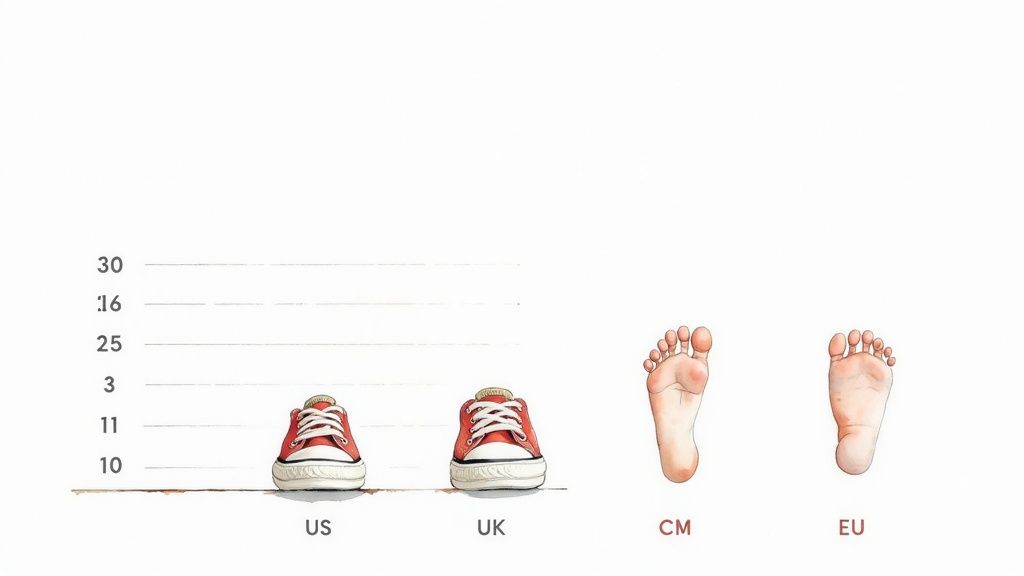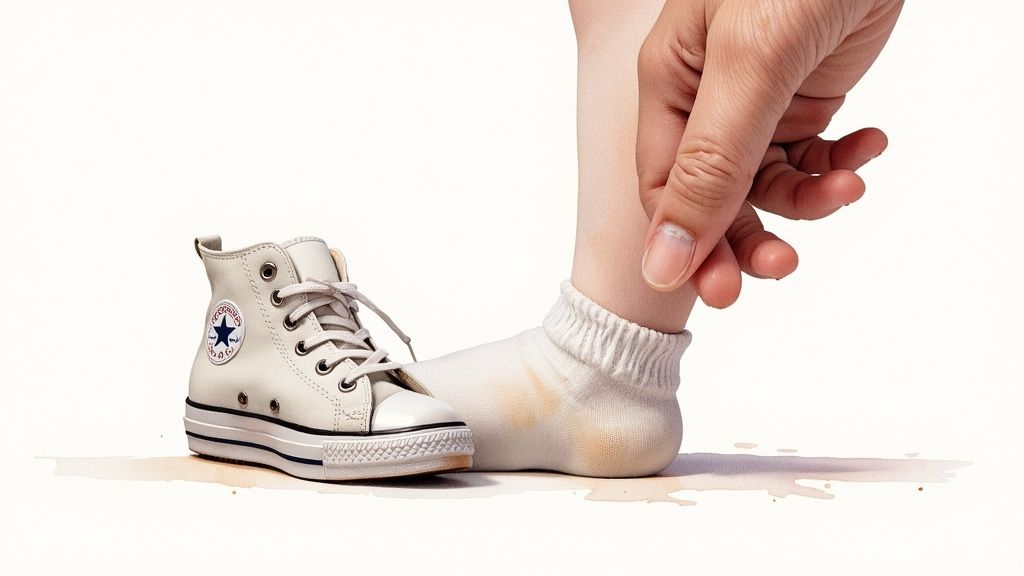Finding the right shoe size for a wiggly toddler can feel like an impossible mission, can't it? One minute they're still, the next they're off on an adventure! To take the guesswork out of choosing their next pair of iconic sneakers, we've put together this simple guide to the toddler Converse size chart. It lines up US, UK, EU, and centimeter (cm) measurements to give you a quick, reassuring way to find that perfect fit for your little one's feet.
Your Guide to the Toddler Converse Size Chart

It’s completely normal to feel a bit lost when looking at toddler shoe sizes, especially with different sizing systems from around the world. My goal here is to give you that "aha!" moment of clarity, so you can feel confident that your child's first steps—and all the big adventures that follow—are in comfy, supportive shoes. As a parent, I know their safety and comfort is everything.
A proper fit is absolutely crucial for healthy foot development. A toddler's feet are still so soft and malleable, which means shoes that are too tight can hamper growth. On the flip side, shoes that are too loose can lead to stumbles, trips, or painful blisters. That’s why getting an accurate measurement from the start is so important.
Getting Started on the Right Foot
This guide will walk you through absolutely everything you need to know. We'll cover:
- How to accurately measure those tiny feet right at home (with a few tricks to make it fun!).
- Tips for reading the size chart and leaving a little room for those inevitable growth spurts.
- How to spot and solve common fit issues before they become a problem.
Consider this your go-to playbook for making sure those adorable new sneakers are a perfect match. For little ones just starting their walking journey, our collection of soft-soled first-step baby shoes offers a gentle introduction to footwear.
Now, let's get those little feet ready for exploring!
Why Getting the Right Shoe Size Is a Big Deal for Toddlers
Watching your little one take those first wobbly steps is pure magic, isn't it? As they graduate from crawling to confidently toddling around, their shoes become so much more than a cute accessory. They're a vital part of their healthy development. A toddler's feet are incredibly soft and flexible because the bones are still forming, which makes them super sensitive to pressure from shoes that don't fit just right.
A snug, well-fitting shoe gives them the stability and support they need to master their balance and walk with confidence. When shoes fit perfectly, they let your toddler's feet grow and move naturally, without being squished. This is key to avoiding things like painful blisters, angry red marks, or even ingrown toenails that can turn the adventure of walking into a tearful ordeal.
Supporting Healthy Growth and Natural Movement
Think about it: shoes that are too tight can cramp their little toes, preventing them from spreading out naturally—a motion that’s super important for balance. On the flip side, shoes that are too loose can cause their foot to slide around inside, leading to a clumsy gait and a much higher chance of tripping and falling.
The sweet spot is a shoe that feels like a protective second skin, not a rigid box. It needs to be flexible enough for them to move freely, but with just enough structure to support their explorations on all sorts of terrain, from your living room carpet to the grass at the park.
A Growing Market for Those Fast-Growing Feet
If you feel like you're constantly buying new shoes, you're not alone! Toddlers' feet grow at an astonishing rate, sometimes needing a new pair every few months. This rapid growth is a huge driver behind the baby footwear industry. In fact, market research suggests the global baby shoes market is on track to hit about USD 97.4 billion by 2035, with iconic brands like Converse leading the charge.
This just goes to show how much parents all over the world care about getting this right. You can dive deeper into these trends and see how the market is focusing on tiny feet in this detailed report.
A Quick Tip for Parents: Make it a habit to check the fit of your toddler’s shoes every 6-8 weeks. A growth spurt can literally happen overnight, and what fit like a glove last month could be way too tight today. Regular checks are the best way to make sure their feet always have the space they need.
How to Measure Your Toddler's Feet at Home
Let's be real—measuring a wiggly toddler's feet can feel like trying to catch a greased watermelon. But I promise, we can make this quick, painless, and maybe even a little fun. Getting an accurate measurement is your first big step toward using our toddler Converse size chart correctly and finding that perfect, comfy fit.

The classic "trace and measure" method has stuck around for a reason—it just works! All you need is a piece of paper, a pen or crayon, and a ruler. Let's get it done.
The Simple Trace and Measure Method
You can nail this in just a few minutes. Here’s how to do it, step-by-step:
- Get on Solid Ground: Have your toddler stand on a piece of paper placed on a hard, flat floor, not a squishy rug. This helps their foot flatten out naturally for the most accurate tracing.
- Outline the Foot: While they're standing, carefully trace around their foot. The trick is to keep your pen straight up and down, not angled in or out, so you get a true-to-size outline.
- Measure Heel to Toe: Now that your little one is free to run off, grab your ruler. Measure the tracing from the very back of the heel to the tip of their longest toe—and remember, that isn't always the big toe!
- Do Both Feet: It’s super common for one foot to be slightly bigger than the other. Always measure both feet and use the measurement from the larger foot to pick the size.
Parenting Pro-Tip: Try to measure your toddler's feet in the afternoon or evening. Just like our feet, theirs can swell a tiny bit throughout the day. Measuring later ensures their new shoes will still be comfy after a long day of adventure.
Tips for Measuring a Wiggly Toddler
I know, keeping a toddler still is a big ask! Sometimes a little distraction is all you need. Turn on their favorite cartoon or hand them a toy they love while you do a quick trace. You can also make a game out of it. "Let's make a picture of your foot!" often works wonders and turns a chore into a fun little project.
Make sure they're standing with their weight spread evenly across both feet. You want to capture the natural splay of their foot, which is how it will sit inside the shoe when they're walking and playing.
Finally, don't forget the socks! For everyday Converse, measure their feet while they're wearing the kind of socks they'll normally be in. If you're sizing up for winter, you might even want to measure with a thicker pair on. Getting this right is a key part of the puzzle. For more on this, check out our guide to infant sock sizes.
Now that you have your measurement, you're all set to find that perfect pair!
Making Sense of the Converse Sizing Details

Alright, you've got your toddler's foot measurement. Now, let's translate that number into the right shoe size. Staring at a size chart with all those columns—US, UK, EU—can feel a little overwhelming at first, but I promise it's more straightforward than it seems. We'll walk through it together so you can pick the perfect pair with confidence.
The most crucial number you have is the one in centimeters (cm). Think of it as your universal key. It connects your child’s actual foot length directly to the right size in any system, which really helps cut through the confusion.
Connecting Centimeters to US Toddler Sizes
The toddler Converse size chart is built with one thing in mind: the fast-and-furious growth of little feet. Let’s make this real. Say you measured your toddler's foot and it came out to 12.7 cm. You'd just find that number in the "Foot Length (cm)" column on a chart. Right next to it, you'll see it lines up perfectly with a US size 5T.
See? It’s really that simple. Measuring and matching is always the most reliable way to shop because you’re basing your choice on their actual size, not just their age or what they wore in a different brand.
Converse’s toddler chart is specifically designed for kids aged roughly 1 to 5 years, covering sizes from 4T to 10.5T. For example, a size 5T fits a foot that’s 5.0 inches (12.7 cm), a size 6T is for 5.3 inches (13.5 cm), and a size 10.5T fits a 6.8-inch foot (17.3 cm). Each size goes up by about 0.3 to 0.5 inches, which is right in line with how toddlers’ feet typically grow.
If you want to dive even deeper, you can explore a full breakdown of how Converse sizes their shoes for kids.
Pro Tips for Nailing the Perfect Converse Fit

Okay, so you've measured those tiny feet and checked them against the size chart. High five! That's the biggest hurdle. But to really guarantee those new Chucks are comfy and safe, a few extra little checks can make all the difference. Let's make sure those sneakers are a perfect fit, with just enough room for your little one to grow.
The oldest trick in the book is still the best one: the classic "rule of thumb." Once the shoe is on, have your toddler stand up and press your thumb down on the front of the shoe, right above their longest toe. You’re looking for about a thumb's width of space between their toe and the end of the sneaker.
Why is this little gap so important?
- Room to Grow: It accommodates those sudden growth spurts that seem to happen overnight.
- Freedom to Move: It lets their toes spread out naturally, which is crucial for balance and development.
- Comfort is King: It keeps their toes from getting pinched or squished during a long day of play.
Don't Forget the Socks! (And When to Size Up)
Here’s something that’s easy to overlook: socks. The fit of a shoe can change quite a bit depending on whether your toddler is wearing thin ankle socks or a thick, fluffy winter pair. When you're trying on shoes for a specific season, make sure they’re wearing the kind of socks they'll most likely have on with them.
You might have heard that Converse tend to run a little big, and it's often true. This can be a huge plus, as it frequently gives you that growth room right out of the box. But if your child's measurement falls right between two sizes, it's almost always a good idea to go with the larger one. A shoe that’s a tiny bit loose is way better than one that’s too snug.
And what about those brand-new walkers? A classic, firm-soled Converse might be a little much for their first wobbly steps. At this stage, you want something soft and flexible that feels as close to barefoot as possible. Our Baby Anti-Slip Prewalker Sneakers are made exactly for this, with a soft TPR sole that protects their feet without getting in the way of natural movement.
The Red Mark Test: After your little one has been running around in their new shoes for a while, take them off and give their feet a quick look. See any red marks or indentations? If not, you've nailed the fit! It’s the simplest, most reliable way to know they're truly comfortable.
What If the Fit Still Isn't Right? Troubleshooting Common Issues
Even after you've measured with precision, a new pair of shoes can sometimes be a little... off. Don't stress! This is totally normal. Every little foot is wonderfully unique, with its own quirks and chubby spots. Let's walk through how to troubleshoot those tricky fit problems and get your toddler moving comfortably.
The clearest sign of a bad fit often comes straight from your little one. If they're constantly yanking their shoes off, getting fussy when it's time to put them on, or suddenly seem wobbly on their feet, they might be trying to tell you something's not right.
The Quick Fit Check
Once your toddler has had a chance to wear their new Converse for a bit, it's the perfect time for a quick check-in. This little routine can give you some serious peace of mind.
- Check for Red Marks: When you take off their shoes and socks, have a gentle look at their feet. Do you see any red spots or indentations? Pay close attention to the heels, ankles, and the top of the foot. These are the classic signs of rubbing or a fit that's just too snug.
- Feel for Tightness: With their foot still in the shoe, run your finger across the top. Does the material feel strained or overly tight? A great fit should feel secure, but never restrictive.
- Watch Their Walk: Just observe them for a minute. Are they walking with their usual confidence, or do they seem a little clumsy? Shoes that are too big can be a real trip hazard.
Common Problems and Easy Fixes
Sometimes the issue is a bit more specific than just the overall size. Here are a couple of common scenarios and what you can do about them.
Problem: The shoes seem long enough, but they look too tight over the top of their foot.
Solution: Toddlers are famous for those adorably chubby, high-instep feet! If the length is spot-on but the width is a problem, try looking for styles with adjustable velcro straps. They offer a lot more wiggle room than traditional laces. Often, just loosening the laces a bit can make all the difference.
It's worth remembering that a little hesitation about new shoes is normal—they love being barefoot, after all! But you know your child better than anyone. If your parent-intuition is telling you something is off with the fit, trust it. Happy, confident steps all start with comfortable shoes.
Got Questions About Toddler Shoes? We've Got Answers.
We get asked about toddler shoe sizing all the time. It can feel a little tricky, right? So, we've pulled together the most common questions we hear from parents, creating a quick guide to clear up any lingering doubts. We want you to feel totally confident you're making the best choice for those tiny, busy feet.
How Often Should I Measure My Toddler's Feet?
It feels like one minute you buy them new shoes, and the next, they’ve outgrown them! Toddlers' feet grow astonishingly fast, which is why it’s a great idea to get into the habit of measuring them every six to eight weeks.
A quick measure this often means you’ll catch that next growth spurt right away, long before their current pair starts to feel tight and uncomfortable.
What If My Toddler Is Between Two Sizes?
This happens all the time. You measure their foot, check the toddler Converse size chart, and they fall squarely between two sizes. So, what do you do?
Our advice is always the same: choose the larger size. A little bit of extra room for their toes to wiggle and grow is so much better for their developing feet than a shoe that's even a tiny bit snug. Plus, it gives you a little more wear-time before the next size-up is needed.
A little insider tip: Many parents find that Converse actually run a bit large anyway. Sizing up usually gives you that perfect "thumb's width" of wiggle room we always recommend, right out of the box.
Are Classic Converse Good for New Walkers?
That's a fantastic question, and one we hear a lot. While we absolutely adore the timeless look of classic Chucks, they're generally better suited for toddlers who are already walking with confidence and stability. For those very first wobbly steps, most pediatric physical therapists recommend a shoe that's super flexible—as close to barefoot as you can get.
Here’s a quick rundown on why a softer, more flexible sole is the gold standard for beginners:
- Promotes Natural Development: It lets all those tiny muscles in their feet and ankles build strength naturally, without being restricted.
- Improves Balance: A flexible sole allows them to really feel the ground beneath them, which is crucial for developing good balance and coordination.
- Allows for Unhindered Movement: It doesn't get in the way of their toes splaying naturally as they learn to find their footing.
Once your little one is walking confidently around the neighborhood and needs more protection for their outdoor adventures, a sturdier shoe like a classic Converse becomes a fantastic choice.
At Mimou Babywear, we believe every step—especially the very first one—deserves to be comfortable and supported. Our entire collection is designed with your child's well-being at its heart, using only the softest, safest materials for all their big (and little) adventures. Explore our thoughtfully curated baby and toddler essentials at mimoubabywear.com.





